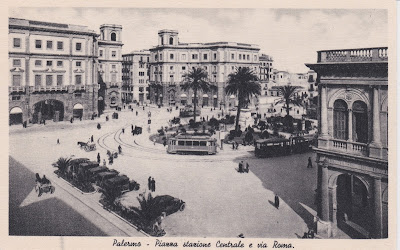Palermo central square, Sicily, Italy, ca 1910-1920
This black & white photo postcard dates from the early 1900s and shows the Central Square in the city of Palermo, Sicily, Italy, with part of the railway station visible at the lower right. The national rail company, Ferrovie dello Stato (FS), owns this rail station. It was designed by the Italian architect, Di Giovanni and opened in 1886. One of the original main characteristics of the building, the big roof shown here in iron and glass, was replaced by reinforced concrete sometime during the 1950s. The terminal has 10 platforms for passenger service. It is one of the most important national rail stations in this region and serves as a hub for regional services such as links to the Airport of Punta Raisi and long distant trains to Rome, Turin, Milan, Venice and Paris. It not served by EuroStar Trains primarily because Sicily is an island.
No publishing information or photographer is identified on the reverse of the card but it does have a divided back. The divided back on the card plus the mixture of horse drawn carriages, the streetcars, and the line of motorized trucks help date the picture to probably not earlier than 1910 and not later than approximately 1920. Note the circular track that allows the streetcars to return the opposite direction with ease. The central square shows pedestrians walking and standing in the open space. Today many European central plazas are pedestrian only but some would be filled with cars; nevertheless, this square would be considerably more crowded than shown in the photo.
People have been living in this area of Sicily since ancient times, perhaps as early as 8,000 BC as evidenced by cave drawings depicting humans. It is thought that the original settlers came from the Iberian Peninsula. During the time of the Phoenicians, around 734 BC, the main occupation was sea trading. Any remains from this period of time are few and those preserved are in the very center of the downtown. There is also evidence of Greek and Roman influences on the island. As the Roman Empire was falling apart Palermo fell under the control of the Germanic tribes, the Vandals and the Ostrogoths. After 1861 Sicily became part of the new Kingdom of Italy. Today the metropolitan area of Palermo is home to more than 1.2 million people.
For more information, see:
https://en.wikipedia.org/wiki/Palermo
https://en.wikipedia.org/wiki/Palermo_Centrale_railway_station
https://en.wikipedia.org/wiki/Sicily

No comments:
Post a Comment